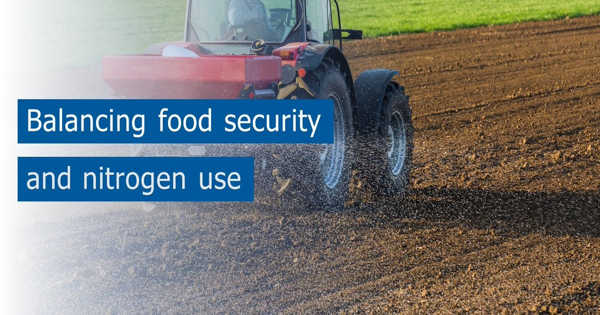To avoid a significant increase in the risk of food insecurity, environmental targets to limit excess nitrogen necessitate the large-scale deployment of dedicated nitrogen mitigation strategies. Without these measures, people’s access to dietary energy would be greatly reduced, resulting in higher food prices and an increase in the number of undernourished people.
Nitrogen is essential in the agricultural industry. Every year, over 100 million tonnes of nitrogen are applied to crops as fertilizer to ensure that enough food is produced to feed the world’s ever-increasing population. Because some of the added nitrogen is not taken up by plants, an inevitable nitrogen surplus results in a run-off to surface water, which contributes to biodiversity loss and algal blooms.
Many regions and countries have proposed or implemented nitrogen pollution reduction measures in an effort to address this issue and improve the health of both people and ecosystems. However, there is still a lack of understanding of the trade-offs that exist between food security (which necessitates the use of nitrogen) and environmental goals (which require a reduction in nitrogen use).
In a new study, researchers explored the possible effects that current nitrogen-related mitigation options could have on reconciling regional food security and environmental targets for nitrogen.
In a new study published in the journal Science, a team of researchers from the International Institute for Applied Systems Analysis (IIASA), Wageningen University in the Netherlands, Zhejiang University in China, and Ritsumeikan University in Japan investigated the possible effects that current nitrogen-related mitigation options could have on reconciling regional food security and environmental nitrogen targets. They calculated regional nitrogen surplus boundaries for 37 global regions and demonstrated that current nitrogen inputs cross those boundaries in 14 of them, including high nitrogen input regions like China, India, and Western Europe.
They then weighed the trade-offs between regional food security and reaching those nitrogen limits under current management. They also identified the effects of mitigation options for resolving the conflict between regional food production and nitrogen environmental targets.

“Our findings suggest that policies encouraging the mobilization of a comprehensive set of nitrogen mitigation options would allow for compliance with proposed nitrogen sustainability boundaries while not jeopardizing global food security. Even when regional nitrogen surplus boundaries are respected, hunger could be significantly reduced, putting 590 million fewer people at risk of hunger from 2010 to 2050. Beyond the effects of nitrogen pollution, such policies may have other environmental and economic co-benefits “explains study lead author Jinfeng Chang, a researcher in the IIASA Biodiversity and Natural Resources Program’s Integrated Biosphere Futures Research Group.
Several strategies were considered by the researchers, including encouraging higher nitrogen use efficiency in agronomic practices, improving manure recycling and sewage management, reducing harvest losses and food waste, and encouraging a shift away from animal products in diets.
Increasing nitrogen use efficiency emerged as the most effective strategy for reducing undernourishment while adhering to the nitrogen-boundaries. However, given the magnitude of the problem, policies that facilitate and encourage multiple nitrogen mitigation options, both on the supply and demand sides, must be implemented concurrently in order to address nitrogen pollution.
“A balance between food availability and regional nitrogen surplus boundaries could also be improved through international trade in agricultural products by promoting exports from regions that are not exceeding their nitrogen boundaries to regions that need to reduce their nitrogen inputs in order to address a nitrogen surplus,” Chang adds.
“However, if efforts to reduce the nitrogen surplus in middle-income developing regions such as East Asia, the Middle East, North Africa, or South Asia are based on reduced domestic supply rather than improving nitrogen use efficiency, the consequences for food security in less developed regions such as Sub-Saharan Africa and Southeast Asia could be severe. It may also aggravate other environmental issues, such as deforestation in Latin America “He comes to an end.















